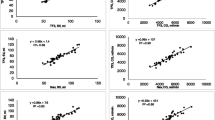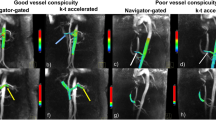Abstract
The aim of this prospective study is to compare the performance of 2D time-resolved phase-contrast (PC) MRI prior to and after the administration of an intravascular (gadofosveset-trisodium) and extravascular (gadopentetate-dimeglumine) contrast agent in the same patient in the cardiovascular system. This study was approved by the ethics committee (Study-Number-07/Q0704/2) and registered with the MedicinesAndHealthcareProductsRegulatoryAgency (MHRA-Study-Number-28482/0002/001-0001, EudraCT-Number-2006-007042). All patients signed an informed consent. 20 patients were examined using a 1.5T MR-scanner and 32-channel-coil-technology. Gadopentetate-dimeglumine (GdD) and gadofosveset-trisodium (GdT) were administered in the same patient on consecutive days. Image quality, velocity-to-noise-ratios (VNRs) and standard-deviation of blood-flow-velocities (phase-noise) were compared between GdT, GdD and non-contrast-enhanced imaging. On both days pre- and post-contrast-scans were performed. The administration of GdT significantly improved the delineation of the perfused lumen and the VNR compared to GdD and non-contrast-enhanced imaging. Standard deviations of through-plane and in-plane velocity-measurements (phase-noise) were significantly reduced after GdT administration (p < 0.05). No significant differences (p > 0.05) were measured regarding absolute flow values prior to and after the administration of GdD and GdT. PC flow imaging benefits from the administration of an intravascular contrast agent by improving the delineation of the perfused lumen and reducing phase noise in flow measurements.



Similar content being viewed by others
References
Greil GF, Geva T, Maier SE, Powell AJ (2002) Effect of acquisition parameters on the accuracy of velocity encoded cine magnetic resonance imaging blood flow measurements. J Magn Reson Imaging 15(1):47–54
Frayne R, Steinman DA, Ethier CR, Rutt BK (1995) Accuracy of MR phase contrast velocity measurements for unsteady flow. J Magn Reson Imaging 5(4):428–431
Kondo C, Caputo GR, Semelka R, Foster E, Shimakawa A, Higgins CB (1991) Right and left ventricular stroke volume measurements with velocity-encoded cine MR imaging: in vitro and in vivo validation. AJR Am J Roentgenol 157(1):9–16
Mostbeck GH, Caputo GR, Higgins CB (1992) MR measurement of blood flow in the cardiovascular system. AJR Am J Roentgenol 159(3):453–461
Kilner PJ, Firmin DN, Rees RS et al (1991) Valve and great vessel stenosis: assessment with MR jet velocity mapping. Radiology 178(1):229–235
Sakuma H, Kawada N, Takeda K, Higgins CB (1999) MR measurement of coronary blood flow. J Magn Reson Imaging 10(5):728–733
Sakuma H, Kawada N, Takeda K, Higgins CB (1999) MR measurement of coronary blood flow. J Magn Reson Imaging 10(5):728–733
Hays AG, Hirsch GA, Kelle S, Gerstenblith G, Weiss RG, Stuber M (2010) Noninvasive visualization of coronary artery endothelial function in healthy subjects and in patients with coronary artery disease. J Am Coll Cardiol 56(20):1657–1665
Lee VS, Spritzer CE, Carroll BA et al (1997) Flow quantification using fast cine phase-contrast MR imaging, conventional cine phase-contrast MR imaging, and Doppler sonography: in vitro and in vivo validation. AJR Am J Roentgenol 169(4):1125–1131
Lauffer RB, Parmelee DJ, Dunham SU et al (1998) MS-325: albumin-targeted contrast agent for MR angiography. Radiology 207(2):529–538
Lotz J, Doker R, Noeske R et al (2005) In vitro validation of phase-contrast flow measurements at 3 T in comparison to 1.5 T: precision, accuracy, and signal-to-noise ratios. J Magn Reson Imaging 21(5):604–610
Saeed M, Wendland MF, Higgins CB (2000) Blood pool MR contrast agents for cardiovascular imaging. J Magn Reson Imaging 12(6):890–898
Schoenberg SO, Just A, Bock M, Knopp MV, Persson PB, Kirchheim HR (1997) Noninvasive analysis of renal artery blood flow dynamics with MR cine phase-contrast flow measurements. Am J Physiol 272(5 Pt 2):H2477–H2484
Heverhagen JT, Hoppe M, Klose KJ, Wagner HJ (2002) Does the application of gadolinium-DTPA have an impact on magnetic resonance phase contrast velocity measurements? Results from an in vitro study. Eur J Radiol 44(1):65–69
Bass JC, Prince MR, Londy FJ, Chenevert TL (1997) Effect of gadolinium on phase-contrast MR angiography of the renal arteries. AJR Am J Roentgenol 168(1):261–266
Hartmann M, Wiethoff AJ, Hentrich HR, Rohrer M (2006) Initial imaging recommendations for Vasovist angiography. Eur Radiol 16(Suppl 2):B15–B23
Stalder AF, Dong Z, Yang Q et al (2012) Four-dimensional flow-sensitive MRI of the thoracic aorta: 12- versus 32-channel coil arrays. J Magn Reson Imaging 35(1):190–195
Frydrychowicz A, Stalder AF, Russe MF et al (2009) Three-dimensional analysis of segmental wall shear stress in the aorta by flow-sensitive four-dimensional-MRI. J Magn Reson Imaging 30(1):77–84
Frydrychowicz A, Schlensak C, Stalder A et al (2007) Ascending-descending aortic bypass surgery in aortic arch coarctation: four-dimensional magnetic resonance flow analysis. J Thorac Cardiovasc Surg 133(1):260–262
Nett EJ, Johnson KM, Frydrychowicz A et al (2012) Four-dimensional phase contrast MRI with accelerated dual velocity encoding. J Magn Reson Imaging 35(6):1462–1471
Wong J, Mathur S, Giese D et al (2012) Analysis of aortopulmonary window using cardiac magnetic resonance imaging. Circulation 126(15):e228–e229
Markl M, Kilner PJ, Ebbers T (2011) Comprehensive 4D velocity mapping of the heart and great vessels by cardiovascular magnetic resonance. J Cardiovasc Magn Reson 13:7
Pruessmann KP, Weiger M, Scheidegger MB, Boesiger P (1999) SENSE: sensitivity encoding for fast MRI. Magn Reson Med 42(5):952–962
Lee AT, Pike GB, Pelc NJ (1995) Three-point phase-contrast velocity measurements with increased velocity-to-noise ratio. Magn Reson Med 33(1):122–126
Greil GF, Powell AJ, Gildein HP, Geva T (2002) Gadolinium-enhanced three-dimensional magnetic resonance angiography of pulmonary and systemic venous anomalies. J Am Coll Cardiol 39(2):335–341
McConnell MV, Khasgiwala VC, Savord BJ et al (1997) Comparison of respiratory suppression methods and navigator locations for MR coronary angiography. AJR Am J Roentgenol 168(5):1369–1375
Stuber M, Botnar RM, Danias PG et al (1999) Contrast agent-enhanced, free-breathing, three-dimensional coronary magnetic resonance angiography. J Magn Reson Imaging 10(5):790–799
Taylor AM, Panting JR, Keegan J et al (1999) Use of the intravascular contrast agent NC100150 injection in spin-echo and gradient-echo imaging of the heart. J Cardiovasc Magn Reson 1(1):23–32
Gerretsen SC, Versluis B, Bekkers SC, Leiner T (2008) Cardiac cine MRI: comparison of 1.5 T, non-enhanced 3.0 T and blood pool enhanced 3.0 T imaging. Eur J Radiol 65(1):80–85
Wagenseil JE, Johansson LO, Lorenz CH (1999) Characterization of t1 relaxation and blood-myocardial contrast enhancement of NC100150 injection in cardiac MRI. J Magn Reson Imaging 10(5):784–789
Huber S, Muthupillai R, Mojibian H, Cheong B, Kouwenhoven M, Flamm SD (2008) Rapid assessment of regional and global left ventricular function using three-dimensional k-t BLAST imaging. Magn Reson Imaging 26(6):727–738
Ritter CO, Wilke A, Wichmann T, Beer M, Hahn D, Kostler H (2011) Comparison of intravascular and extracellular contrast media for absolute quantification of myocardial rest-perfusion using high-resolution MRI. J Magn Reson Imaging 33(5):1047–1051
Nezafat R, Herzka D, Stehning C, Peters DC, Nehrke K, Manning WJ (2008) Inflow quantification in three-dimensional cardiovascular MR imaging. J Magn Reson Imaging 28(5):1273–1279
Kozerke S, Tsao J (2004) Reduced data acquisition methods in cardiac imaging. Top Magn Reson Imaging 15(3):161–168
Bock J, Frydrychowicz A, Stalder AF et al (2010) 4D phase contrast MRI at 3 T: effect of standard and blood-pool contrast agents on SNR, PC-MRA, and blood flow visualization. Magn Reson Med 63(2):330–338
Frydrychowicz A, Arnold R, Harloff A et al (2008) Images in cardiovascular medicine. In vivo 3-dimensional flow connectivity mapping after extracardiac total cavopulmonary connection. Circulation 118(2):e16–e17
Acknowledgments
This study has received funding by the Department of Health through the National Institute for Health Research (NIHR) comprehensive Biomedical Research Centre award to Guy’s & St Thomas’ NHS Foundation Trust in partnership with King’s College London and King’s College Hospital NHS Foundation Trust. The Division of Imaging Sciences receives also support as the Centre of Excellence in Medical Engineering (funded by the Wellcome Trust and EPSRC; grant number WT 088641/Z/09/Z) as well as the BHF Centre of Excellence (British Heart Foundation award RE/08/03). The magnetic resonance imaging scanner is partly supported by Philips Healthcare. The study was partly supported by Bayer Schering Pharma GmbH. Otherwise there are no financial or other relations that could lead to a conflict of interest.
Conflict of interest
None.
Author information
Authors and Affiliations
Corresponding author
Additional information
Trial registration This study was approved by the ethics committee (Study-Number-07/Q0704/2) and registered with the MedicinesAndHealthcare ProductsRegulatoryAgency (MHRA-Study-Number-28482/0002/001-0001, EudraCT-Number-2006-007042).
Rights and permissions
About this article
Cite this article
Makowski, M.R., Wiethoff, A.J., Ebersberger, H.U. et al. 2D phase contrast blood flow velocity measurements of the thoracic vasculature: comparison of the effect of gadofosveset trisodium and gadopentetate dimeglumine. Int J Cardiovasc Imaging 31, 409–416 (2015). https://doi.org/10.1007/s10554-014-0565-y
Received:
Accepted:
Published:
Issue Date:
DOI: https://doi.org/10.1007/s10554-014-0565-y




